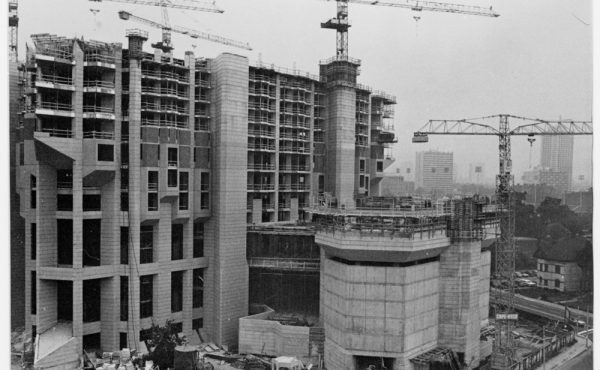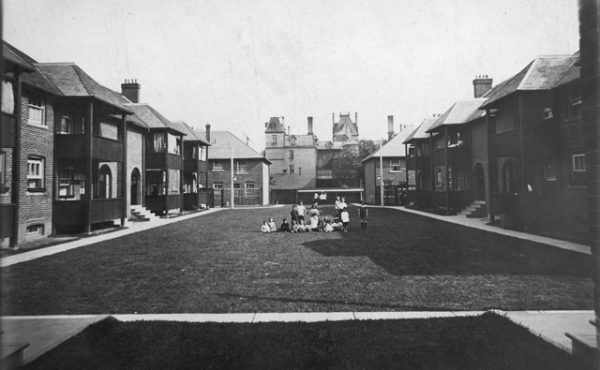 EDITOR: This is the third installment in our series following the Fort York archeological dig of the Government House site. Click here for more background and previous posts on the dig.
EDITOR: This is the third installment in our series following the Fort York archeological dig of the Government House site. Click here for more background and previous posts on the dig.
![]()
It’s hot in the city and if you happen to visit Fort York you can see patches of yellow earth, areas where the grass is drier than the rest of the lawn. These are the traces of old building foundations, yet another subtle sign of history encompassing the downtown national historic site. Also on the lawn is a patch of earth where excavations for remains of the Government House recently ended. One of the most important buildings to be built within the Fort, the Government House was briefly home to four Lieutenant Governors of Upper Canada before it was destroyed by retreating American troops in the spring of 1813.
In 1796 Colonel Simcoe, the first Lieutenant Governor of Upper Canada, gave orders to build a Government House at the eastern edge of the Town of York. When only the wings were completed the building was immediately taken over to be used for many of the town’s needs – to hold parliament, the courts of justice, an early Anglican congregation, etc. In 1799 when General Peter Hunter arrived in York a new Lieutenant Governor’s House was commissioned to be constructed at the Fort. Once built, the vice-regal residence stood prominently on top of the embankment looking out over the lake.

Due to Hunter’s military rank as Lieutenant General of both Upper and Lower Canada the building was commissioned by the Military Chest. This caused complications when Hunter’s civil successor, Francis Gore, arrived in York and was temporarily refused permission to occupy the house due to his lack of military status. After Gore left Upper Canada on home leave General Isaac Brock occupied the Government House as war loomed in 1811. When Brock died in the battle of Queenston Heights the Government House briefly became the residence of Sir Roger Hale Sheaffe, who led the British into battle to defend York in the spring of 1813.
When the War of 1812 came to the doorstep on York, the Government House was in the midst of the battle. The house was damaged by the explosion of the grand magazine but some think that the design of the rampart would have projected the explosion towards the lake and protected the building from the explosion. When the British troops retreated, the residence, along with the entire town, was pillaged by American troops and torched upon their retreat on the first of May. A few months later British troops retaliated by marching south to Washington and torching the Capitol buildings.
Excavations over the past few decades have found what was suspected to be remains of the Government House but the recent excavation was the first aimed directly at finding the residence. It is also one of the only recent archaeological digs in the city to be conducted out of intellectual curiosity (and the commemoration of a war) as opposed to development driven excavations. In the early 1990s during controlled excavations for various service line installations across the central Parade Ground, archaeologists found remains of a charred wooden floor and stone foundations that were thought to be from the Government House and, along with numerous smaller finds, several Queen’s Rangers soldiers’ buttons.

The recent dig was limited to only two weeks and a small area. During the last week, excavations were focused on one corner of the operation where a few foundation stones were found, some still coated in mortar, as well as ceramic pieces from the same era. “We believe we have a robbed-out foundation but it is too early to say what part of the house it is from. We won’t know until the plan is overlaid with previous excavations,” explained Eva McDonald, the excavation director. The reason the excavation did not reveal a more definitive wall is likely due to the fact that building materials were far more expensive two hundred years ago and any rubble from the Government House would have been salvaged when reconstructing the fort after the war.
Archaeology itself is not (always) about finding the treasure but rather “it is a compounding science” said Stephen Otto, one of the co-founders of Friends of Fort York, “any excavation builds on previous ones, helps fill in gaps of historical documents, and helps build our knowledge piece by piece like a mosaic of knowledge.” Yet it is also a destructive science that destroys as fast as it finds; it is impossible to put the site back the way one found it. Archaeology has changed drastically over the years and archaeologists take artefacts sparingly, “it takes discipline to hold back and be cautious” said Stephen. It is quite clear that the ASI archaeologists involved in the excavations are aware of this and have the upmost respect for the history at Fort York. As Eva explained, “the Government House is part of the oldest and largest urban archaeological site in the city; it was a privilege to be able to work there.”



